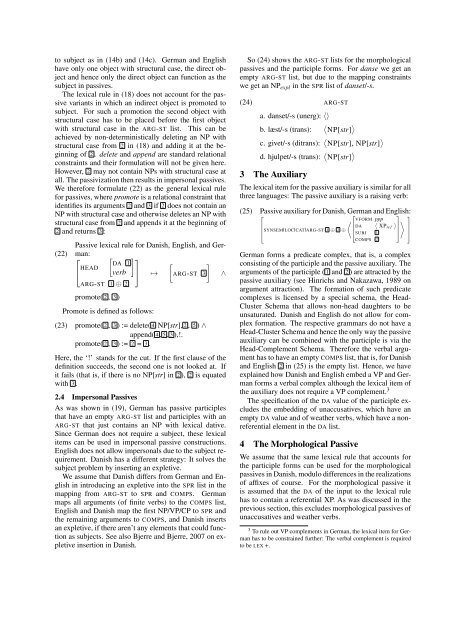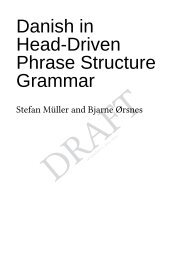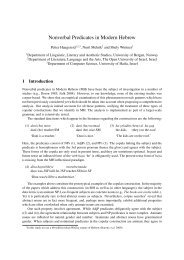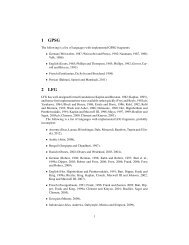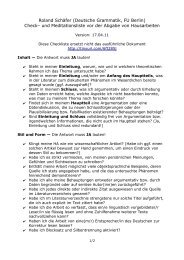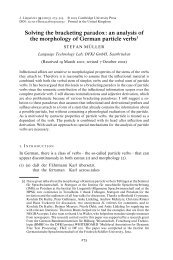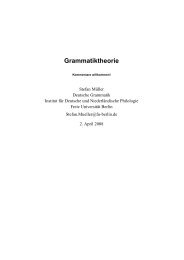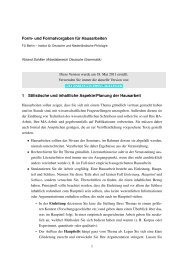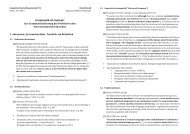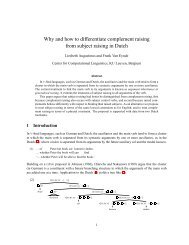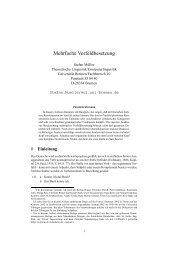Passive in Danish, English, and German - German Grammar Group ...
Passive in Danish, English, and German - German Grammar Group ...
Passive in Danish, English, and German - German Grammar Group ...
You also want an ePaper? Increase the reach of your titles
YUMPU automatically turns print PDFs into web optimized ePapers that Google loves.
to subject as <strong>in</strong> (14b) <strong>and</strong> (14c). <strong>German</strong> <strong>and</strong> <strong>English</strong><br />
have only one object with structural case, the direct object<br />
<strong>and</strong> hence only the direct object can function as the<br />
subject <strong>in</strong> passives.<br />
The lexical rule <strong>in</strong> (18) does not account for the passive<br />
variants <strong>in</strong> which an <strong>in</strong>direct object is promoted to<br />
subject. For such a promotion the second object with<br />
structural case has to be placed before the first object<br />
with structural case <strong>in</strong> the ARG-ST list. This can be<br />
achieved by non-determ<strong>in</strong>istically delet<strong>in</strong>g an NP with<br />
structural case from 2 <strong>in</strong> (18) <strong>and</strong> add<strong>in</strong>g it at the beg<strong>in</strong>n<strong>in</strong>g<br />
of 2 . delete <strong>and</strong> append are st<strong>and</strong>ard relational<br />
constra<strong>in</strong>ts <strong>and</strong> their formulation will not be given here.<br />
However, 2 may not conta<strong>in</strong> NPs with structural case at<br />
all. The passivization then results <strong>in</strong> impersonal passives.<br />
We therefore formulate (22) as the general lexical rule<br />
for passives, where promote is a relational constra<strong>in</strong>t that<br />
identifies its arguments 2 <strong>and</strong> 3 if 2 does not conta<strong>in</strong> an<br />
NP with structural case <strong>and</strong> otherwise deletes an NP with<br />
structural case from 2 <strong>and</strong> appends it at the beg<strong>in</strong>n<strong>in</strong>g of<br />
2 <strong>and</strong> returns 3 :<br />
(22)<br />
<strong>Passive</strong> lexical rule for <strong>Danish</strong>, <strong>English</strong>, <strong>and</strong> Ger-<br />
man:<br />
⎡<br />
⎣ HEAD<br />
DA 1<br />
verb<br />
ARG-ST 1 ⊕ 2<br />
promote( 2 , 3 )<br />
⎤<br />
⎦ ↦→<br />
Promote is def<strong>in</strong>ed as follows:<br />
<br />
ARG-ST 3<br />
(23) promote( 2 , 3 ) := delete( 4 NP[str], 2 , 5 ) ∧<br />
append( 4 , 5 , 3 ),!.<br />
promote( 2 , 3 ) := 2 = 3 .<br />
Here, the ‘!’ st<strong>and</strong>s for the cut. If the first clause of the<br />
def<strong>in</strong>ition succeeds, the second one is not looked at. If<br />
it fails (that is, if there is no NP[str] <strong>in</strong> 2 ), 2 is equated<br />
with 3 .<br />
2.4 Impersonal <strong>Passive</strong>s<br />
As was shown <strong>in</strong> (19), <strong>German</strong> has passive participles<br />
that have an empty ARG-ST list <strong>and</strong> participles with an<br />
ARG-ST that just conta<strong>in</strong>s an NP with lexical dative.<br />
S<strong>in</strong>ce <strong>German</strong> does not require a subject, these lexical<br />
items can be used <strong>in</strong> impersonal passive constructions.<br />
<strong>English</strong> does not allow impersonals due to the subject requirement.<br />
<strong>Danish</strong> has a different strategy: It solves the<br />
subject problem by <strong>in</strong>sert<strong>in</strong>g an expletive.<br />
We assume that <strong>Danish</strong> differs from <strong>German</strong> <strong>and</strong> <strong>English</strong><br />
<strong>in</strong> <strong>in</strong>troduc<strong>in</strong>g an expletive <strong>in</strong>to the SPR list <strong>in</strong> the<br />
mapp<strong>in</strong>g from ARG-ST to SPR <strong>and</strong> COMPS. <strong>German</strong><br />
maps all arguments (of f<strong>in</strong>ite verbs) to the COMPS list,<br />
<strong>English</strong> <strong>and</strong> <strong>Danish</strong> map the first NP/VP/CP to SPR <strong>and</strong><br />
the rema<strong>in</strong><strong>in</strong>g arguments to COMPS, <strong>and</strong> <strong>Danish</strong> <strong>in</strong>serts<br />
an expletive, if there aren’t any elements that could function<br />
as subjects. See also Bjerre <strong>and</strong> Bjerre, 2007 on expletive<br />
<strong>in</strong>sertion <strong>in</strong> <strong>Danish</strong>.<br />
<br />
∧<br />
So (24) shows the ARG-ST lists for the morphological<br />
passives <strong>and</strong> the participle forms. For danse we get an<br />
empty ARG-ST list, but due to the mapp<strong>in</strong>g constra<strong>in</strong>ts<br />
we get an NPexpl <strong>in</strong> the SPR list of danset/-s.<br />
(24) ARG-ST<br />
a. danset/-s (unerg): 〈〉<br />
<br />
b. læst/-s (trans): NP[str]<br />
c. givet/-s (ditrans): NP[str], NP[str] <br />
d. hjulpet/-s (trans): NP[str] <br />
3 The Auxiliary<br />
The lexical item for the passive auxiliary is similar for all<br />
three languages: The passive auxiliary is a rais<strong>in</strong>g verb:<br />
(25) <strong>Passive</strong> auxiliary for <strong>Danish</strong>, <strong>German</strong> <strong>and</strong> <strong>English</strong>:<br />
⎡<br />
⎡<br />
⎤<br />
VFORM ppp<br />
<br />
⎢<br />
⎢<br />
⎢<br />
⎣SYNSEM|LOC|CAT|ARG-ST 1 ⊕ 2 ⊕ ⎢DA<br />
XPre<br />
⎥<br />
f ⎥<br />
⎣SUBJ<br />
1 ⎦<br />
⎤<br />
⎥<br />
⎦<br />
COMPS 2<br />
<strong>German</strong> forms a predicate complex, that is, a complex<br />
consist<strong>in</strong>g of the participle <strong>and</strong> the passive auxiliary. The<br />
arguments of the participle ( 1 <strong>and</strong> 2 ) are attracted by the<br />
passive auxiliary (see H<strong>in</strong>richs <strong>and</strong> Nakazawa, 1989 on<br />
argument attraction). The formation of such predicate<br />
complexes is licensed by a special schema, the Head-<br />
Cluster Schema that allows non-head daughters to be<br />
unsaturated. <strong>Danish</strong> <strong>and</strong> <strong>English</strong> do not allow for complex<br />
formation. The respective grammars do not have a<br />
Head-Cluster Schema <strong>and</strong> hence the only way the passive<br />
auxiliary can be comb<strong>in</strong>ed with the participle is via the<br />
Head-Complement Schema. Therefore the verbal argument<br />
has to have an empty COMPS list, that is, for <strong>Danish</strong><br />
<strong>and</strong> <strong>English</strong> 2 <strong>in</strong> (25) is the empty list. Hence, we have<br />
expla<strong>in</strong>ed how <strong>Danish</strong> <strong>and</strong> <strong>English</strong> embed a VP <strong>and</strong> <strong>German</strong><br />
forms a verbal complex although the lexical item of<br />
the auxiliary does not require a VP complement. 3<br />
The specification of the DA value of the participle excludes<br />
the embedd<strong>in</strong>g of unaccusatives, which have an<br />
empty DA value <strong>and</strong> of weather verbs, which have a nonreferential<br />
element <strong>in</strong> the DA list.<br />
4 The Morphological <strong>Passive</strong><br />
We assume that the same lexical rule that accounts for<br />
the participle forms can be used for the morphological<br />
passives <strong>in</strong> <strong>Danish</strong>, modulo differences <strong>in</strong> the realizations<br />
of affixes of course. For the morphological passive it<br />
is assumed that the DA of the <strong>in</strong>put to the lexical rule<br />
has to conta<strong>in</strong> a referential XP. As was discussed <strong>in</strong> the<br />
previous section, this excludes morphological passives of<br />
unaccusatives <strong>and</strong> weather verbs.<br />
3 To rule out VP complements <strong>in</strong> <strong>German</strong>, the lexical item for <strong>German</strong><br />
has to be constra<strong>in</strong>ed further: The verbal complement is required<br />
to be LEX +.


